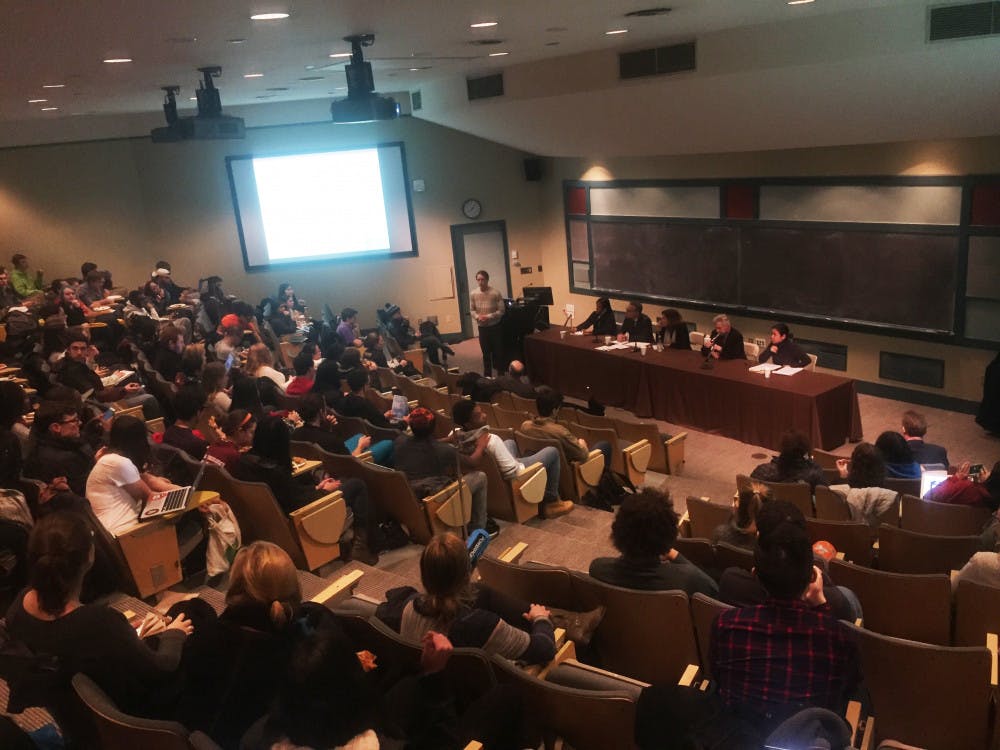“This isn’t to put you on the spot, but it’s to put you on the spot,” said Mae Verano ’17, addressing a panel of five University administrators at an open forum dedicated to the University’s recently released action plan for diversity and inclusion hosted by the Undergraduate Council of Students Tuesday.
Verano’s concerns were about the perceived “fragility” of administrators in dealing with the issues of promoting diversity, one of many criticisms levied by students who assert the plan is non-inclusive and that it is insufficient to meet the challenges of ensuring a diverse community.
The forum stoked heated discussion between students and the five panelists: Provost Richard Locke P’17; Dean of the College Maud Mandel; Vice President for Academic Development, Diversity and Inclusion Liza Cariaga-Lo; Interim Assistant Vice President for Campus Life and Student Services Mary Grace Almandrez; and Dean of the Faculty Kevin McLaughlin P’12.
Locke opened by touting the plan’s mission to “establish a set of concrete, achievable actions to promote diversity and inclusion and confront issues of racism, power, privilege and inequity … on campus.” The plan includes four categories for targeted intervention — the campus community, investing in people, academic leadership and accountability.
The plan calls upon academic departments to take the lead in implementing changes, and the responsibility for enacting diversity promotion falls largely to them, Locke said. “Every department has to own this.”
Attending students identified a variety of areas they feel deserve more attention.
Candice Ellis ’16 brought up issues of “fear and insecurity” about the plan and its recommended changes voiced by community members who do not belong to a minority group. She cited the presence of a “White Student Union” on campus that perpetrates a “harmful ideology.”
Almandrez stressed the need to identify regressive voices by naming problems of structural oppression for what they are and in turn recognize the “good work” done in response.
“We have to change the conversation,” she said. “People are at different places in their comfort. The challenge is not to cater to the lowest common denominator.”
A key component of addressing the “vulnerability of white students” is including all students in departmental conversations about increasing faculty diversity, Cariaga-Lo said. “We need you to be seen as empowered agents in those departments,” she told the audience.
In response to a question about whether staff in all areas — including facilities management and Dining Services — would be given an opportunity to provide feedback on the plan, Locke said all staff are “encouraged” to raise concerns.
A few students immediately responded with criticism. “Let’s tell the truth here,” said Kobe Pereira ’19.
Only those staff members with Brown email addresses were made aware of that opportunity, said Justice Gaines ’16.
“We do have to recognize that people in facilities and dining don’t have easy access,” Cariaga-Lo said. “We have been in conversations with Human Resources to address this very issue. This is work that we pledge to do.”
Verano called on Locke to alter his statement in light of Pereira’s comments regarding the alleged untruth of administrators’ statements. “The proper response would have been ‘thank you for telling me that’,” she said, meeting wide applause.
“Thank you, that was good feedback,” Locke responded.
The plan’s actions to reform the University’s existing mentoring programs were a target of critique.
Alexandra Sepolen ’16 voiced concerns about the way mentoring programs were presented in the plan as “increasing quantity over quality.”
Belinda Zhou ’17 mentioned that Meiklejohn Peer Advisors were not acknowledged in the plan and that training for Meiklejohn advisors is insufficient to address issues of diversity. “I definitely didn’t feel supported by the leadership in terms of training for navigating difficult conversations,” she said.
“We have a tremendous amount of work to do” to improve the Meiklejohn program, Mandel responded.
International students, including Divya Mehta ’18 and Camila Ruiz Segovia ’18, expressed surprise that the plan did not address this group of students. “There is a perception that all international students are white, rich kids,” Segovia said.
“We’re merged into the category of people of color,” Mehta said. But, she added, “Brown isn’t need-blind for international students.”
Administrators acknowledged the disproportionate role of the Brown Center for Students of Color and independent student activists in educating the community about diversity.
The common mode of communication “should not be the oppressed educating the oppressor,” Almandrez said.
“We want to ensure that individuals who are doing independent work will be justly compensated,” Cariaga-Lo added.





